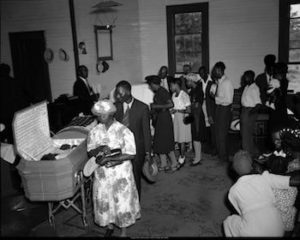
On this date in 1946, the Monroe Massacre occurred. A lynch mob killed two young Black couples.
The episode began when a Black man, Roger Malcolm, was arrested for stabbing his white former employer. A wealthy white planter named J. Loy Harrison posted a bond for Malcolm's release. Harrison was taking Malcolm, his wife, Dorothy, her sister, May Dorsey, and her husband, George Dorsey, back to his farm when a mob of 20 to 30 white men waylaid their car at Moore's Ford Bridge over the Appalachia River connecting Walton and Oconee Counties in Georgia.
While the mob held Harrison and the two women at gunpoint, Malcolm and Dorsey were bound and dragged down an old wagon road. Then, one of the women recognized a member of the mob. He cried out, "Get those damned women out, too." Both couples were tied to a tree while the mob lined up like a firing squad and riddled them with gunfire.
The four were shot hundreds of times in broad daylight by unmasked men. Murder weapons included rifles, shotguns, pistols, and machine guns. The Tuskegee Institute called it a "lynching." Despite an intense investigation by FBI and GBI agents, “The best people in town won't talk," said then-Georgia State Patrol Major William E. Spence. The climate of fear and threat of retaliation discouraged law-abiding citizens from cooperating with the investigation, although they have an idea who it is."
News of the brutal killings and the subsequent cover-up swept across the nation, and the New York Times alone had 43 separate stories in 1946. This incident and two others enraged President Harry Truman. They helped lead to historical changes: the creation of the first-ever presidential commission on race, the desegregation of the military, and the passage of anti-lynching legislation. Yet, this civil rights milestone is nearly forgotten in Walton and Oconee Counties. There is neither mention in local histories nor on historical markers. There is only race-baiting graffiti at the bridge. Today's victims, including World War II veteran Dorsey, lie in unmarked graves.
Almost 50 years later, the Atlanta Journal-Constitution retold the "Monroe Massacre" history after an eyewitness finally came forward. While hiding nearby, Clinton Adams said he saw the killings as a 10-year-old boy. In 1992, he identified four men as shooters, all of whom had died. Although no one was charged, Adams' testimony rekindled interest in the case.
Stunned by this shocking act of violence, area residents finally came forward in a 50-year delayed reaction. In August 1997, a large biracial group of Georgians formed the Moore's Ford Committee to commemorate the Dorseys and the Malcolms. They incorporated and acquired non-profit status to boost fundraising and create a permanent, living memorial.
The Moore's Ford Memorial Committee is committed to telling the story, honoring the dead, promoting healing and social justice, and creating a living memorial for the victims of this horrible crime. This committee includes young and old community leaders, professional and blue-collar workers, county sheriffs, and white and Black residents. The Committee promotes community service, social justice, and racial reconciliation.
In 2017 and 2019, there was a reenactment and a renewed legal battle for closure in this incident.
Atlanta History Center
130 West Paces Ferry Road
Atlanta, GA 30305-1366
Telephone: 404-814-4043